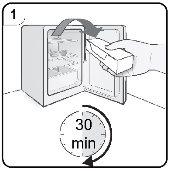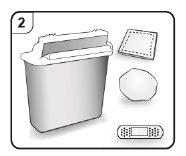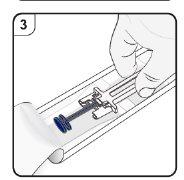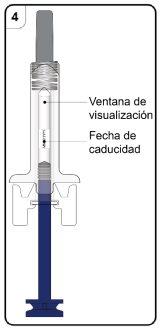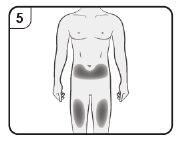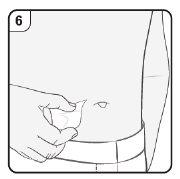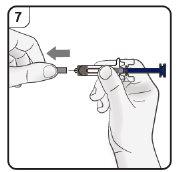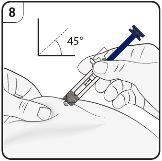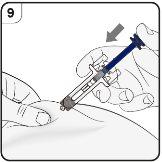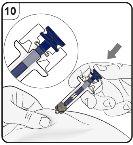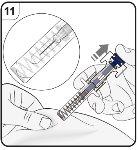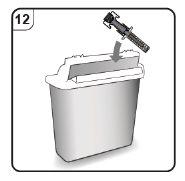
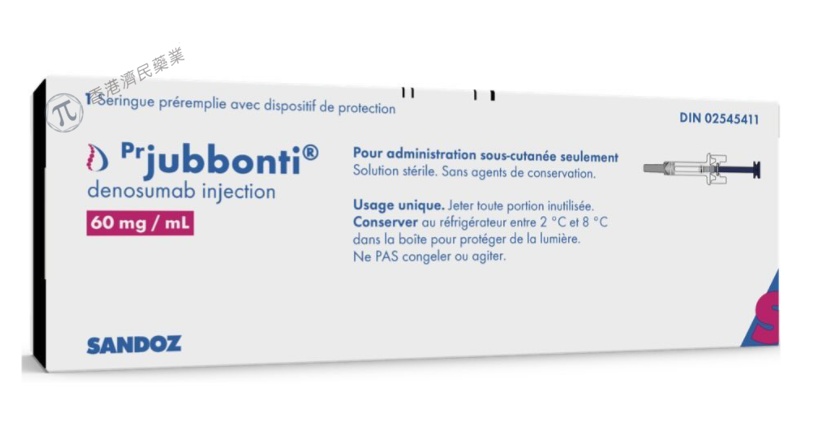
JUBBONTI 60 mg INJECTABLE SOLUTION IN PRE-FILLED SYRINGE


How to use JUBBONTI 60 mg INJECTABLE SOLUTION IN PRE-FILLED SYRINGE
Introduction
Package Leaflet: Information for the User
Jubbonti 60mg solution for injection in pre-filled syringe
denosumab
This medicine is subject to additional monitoring, which will allow for quick identification of new safety information. You can help by reporting any side effects you may get. The last section of section 4 will tell you how to report side effects.
Read all of this leaflet carefully before you start using this medicine because it contains important information for you.
- Keep this leaflet, you may need to read it again.
- If you have any further questions, ask your doctor or pharmacist.
- This medicine has been prescribed for you only. Do not pass it on to others. It may harm them, even if their signs of illness are the same as yours.
- If you get any side effects, talk to your doctor or pharmacist. This includes any possible side effects not listed in this leaflet. See section 4.
- Your doctor will provide you with a patient reminder card, which contains important safety information that you should know before and during treatment with Jubbonti.
Contents of the pack
- What is Jubbonti and what is it used for
- What you need to know before you use Jubbonti
- How to use Jubbonti
- Possible side effects
- Storage of Jubbonti
- Contents of the pack and other information
- Instructions for use
1. What is Jubbonti and what is it used for
What is Jubbonti and how does it work
Jubbonti contains denosumab, a protein (monoclonal antibody) that interferes with the action of another protein to treat bone loss and osteoporosis. Treatment with Jubbonti strengthens bones and reduces the risk of fractures.
Bone is a living tissue that is constantly renewed. Estrogens contribute to the preservation of bone health. After menopause, estrogen levels decrease, which can cause bones to become thinner and more fragile. Over time, this can lead to a disease called osteoporosis. Osteoporosis can also occur in men due to various causes, including age and/or low levels of the male hormone, testosterone. It can also occur in patients undergoing treatment with glucocorticoids. Many patients with osteoporosis do not have symptoms, although they still have a risk of fracturing bones, especially in the spine, hip, and wrists.
Surgical interventions or medications that stop the production of estrogen or testosterone, used to treat patients with prostate or breast cancer, can also cause bone loss. This makes bones weaker and more prone to breaking.
What is Jubbonti used for
Jubbonti is used to treat:
- postmenopausal osteoporosis in women and men at increased risk of fracture (bone breakage), reducing the risk of fractures of the hip, spine, and non-spinal locations.
- bone loss caused by reduced hormonal levels (testosterone) as a result of surgical intervention or treatment with medications in patients with prostate cancer.
- bone loss resulting from long-term treatment with glucocorticoids in patients at high risk of fracture.
2. What you need to know before you use Jubbonti
Do not use Jubbonti:
- if you have low levels of calcium in the blood (hypocalcemia).
- if you are allergic to denosumab or any of the other ingredients of this medicine (listed in section 6).
Warnings and precautions
Consult your doctor or pharmacist before starting treatment with Jubbonti.
During treatment with Jubbonti, you may develop a skin infection with symptoms such as an inflamed and reddened area on the skin, most frequently on the lower leg, which feels hot and sensitive to the touch (cellulitis), and may be accompanied by fever. Inform your doctor immediately if you experience any of these symptoms.
In addition, you should take calcium and vitamin D supplements during treatment with Jubbonti. Your doctor will discuss this with you.
While receiving Jubbonti, you may experience low levels of calcium in the blood. Inform your doctor immediately if you notice any of the following symptoms: muscle spasms, contractions, or cramps, and/or numbness or tingling in the fingers of the hands, feet, or around the mouth, and/or convulsions, confusion, or loss of consciousness.
In rare cases, very low levels of calcium in the blood have been reported, which have required hospitalization and, in some cases, have been life-threatening. Therefore, before each dose is administered and, in patients with a predisposition to hypocalcemia, within two weeks after the initial dose, your blood calcium levels will be checked (through a blood test).
Inform your doctor if you have or have had severe kidney problems, kidney failure, if you have needed to undergo dialysis, or if you are taking medications called glucocorticoids (such as prednisolone or dexamethasone), as they may increase the risk of having low levels of calcium in the blood if you do not take calcium supplements.
Problems in the mouth, teeth, or jaw
In patients receiving denosumab for osteoporosis, a rare side effect called osteonecrosis of the jaw (ONJ) (damage to the jawbone) has been reported. The risk of ONJ increases in patients treated for a long time. ONJ can also occur after treatment is stopped. It is essential to try to prevent the development of ONJ, as it can be a painful condition that can be difficult to treat. To reduce the risk of developing ONJ, follow these precautions:
Before receiving treatment, inform your doctor or nurse (healthcare professional) if:
- you have any problems in your mouth or teeth, such as poor dental health, gum disease, or a planned tooth extraction.
- you do not receive regular dental check-ups or have not had a dental check-up for a long time.
- you are a smoker (as this may increase the risk of dental problems).
- you have been previously treated with a bisphosphonate (used to prevent or treat bone disorders).
- you are taking medications called corticosteroids (such as prednisolone or dexamethasone).
- you have cancer.
Your doctor may ask you to undergo a dental check-up before starting treatment with Jubbonti.
During treatment with Jubbonti, you should maintain good oral hygiene and undergo routine dental check-ups. If you use dental prosthetics, ensure they fit properly. If you are undergoing dental treatment or are about to undergo dental surgery (e.g., tooth extractions), inform your doctor about your dental treatment and inform your dentist that you are being treated with Jubbonti.
Contact your doctor and dentist immediately if you experience any problems in your mouth or teeth, such as loose teeth, pain, or inflammation, or ulcers that do not heal or are suppurating, as these could be symptoms of ONJ.
Unusual fractures of the thigh
Some people have developed unusual fractures of the thigh while being treated with denosumab. Consult your doctor if you experience new or unusual pain in the hip, groin, or thigh.
Children and adolescents
Jubbonti should not be used in children and adolescents under 18 years of age.
Other medicines and Jubbonti
Inform your doctor or pharmacist if you are taking, have recently taken, or might take any other medicines. It is especially important that you inform your doctor if you are being treated with another medicine that contains denosumab.
Do not use Jubbonti with another medicine that contains denosumab.
Pregnancy and breastfeeding
Denosumab has not been tested in pregnant women. It is essential that you inform your doctor if you are pregnant, think you may be pregnant, or plan to become pregnant. Jubbonti is not recommended during pregnancy. Women of childbearing age should use effective contraceptive methods during treatment with Jubbonti and for at least 5 months after stopping treatment with Jubbonti.
If you become pregnant during treatment with Jubbonti or less than 5 months after stopping treatment with Jubbonti, inform your doctor.
It is not known whether denosumab is excreted in breast milk. It is essential that you inform your doctor if you are breastfeeding or plan to breastfeed. Your doctor will help you decide whether to stop breastfeeding or stop using Jubbonti, considering the benefits of breastfeeding for the child and the benefits of Jubbonti for the mother.
If you are pregnant or breastfeeding, think you may be pregnant, or plan to become pregnant, consult your doctor or pharmacist before using this medicine.
Driving and using machines
Jubbonti has no or negligible influence on the ability to drive and use machines.
Jubbonti contains sorbitol
This medicine contains 47 mg of sorbitol per ml of solution.
Jubbonti contains sodium
This medicine contains less than 1 mmol of sodium (23 mg) per ml of solution; this is essentially "sodium-free".
3. How to use Jubbonti
Follow the instructions for administration of this medicine exactly as prescribed by your doctor. If you are unsure, ask your doctor or pharmacist.
The recommended dose is a pre-filled syringe of 60 mg administered under the skin (subcutaneously) in a single injection every 6 months. The best places for injection are the top of the thighs and the abdomen. If the injection is given by a caregiver, it can also be administered in the outer aspect of the upper arm. Consult your doctor for the date of the next possible injection. Each pack of Jubbonti contains a calendar card with a sticker that can be used to keep track of the date of the next injection.
In addition, you should take calcium and vitamin D supplements during treatment with Jubbonti. Your doctor will discuss this with you.
Your doctor may decide whether it is better for you or a caregiver to administer the injection of Jubbonti. Your doctor or healthcare professional will show you or your caregiver how to use Jubbonti.
If you want to obtain instructions on how to inject Jubbonti, read the last section 7 "Instructions for use" of this leaflet.
Before performing the injection, read the entire leaflet, including the Instructions for use. The leaflet is also available through the QR code and the website below:
"Include QR code" + www.jubbonti.eu
Do not shake.
If you forget to use Jubbonti
If you miss a dose of Jubbonti, the injection should be administered as soon as possible. Subsequent injections should be scheduled every 6 months from the date of the last injection.
If you stop treatment with Jubbonti
To get the most benefit from your treatment and reduce the risk of fractures, it is essential that you use Jubbonti for the entire period prescribed by your doctor. Do not stop treatment without talking to your doctor first.
4. Possible side effects
Like all medicines, this medicine can cause side effects, although not everybody gets them.
Patients treated with denosumab may develop skin infections (mainly cellulitis) infrequently. Tell your doctor immediatelyif you experience any of these symptoms during treatment with Jubbonti: an inflamed and reddened area on the skin, usually on the lower leg, which feels hot and sensitive to the touch, and may be accompanied by fever.
Rarely, patients receiving denosumab may develop pain in the mouth and/or jaw, inflammation, or ulcers that do not heal in the mouth or jaw, suppurating, numbness, or a feeling of heaviness in the jaw, or tooth mobility. These could be symptoms of bone damage in the jaw (osteonecrosis). Tell your doctor and dentist immediatelyif you experience such symptoms while being treated with Jubbonti or after stopping treatment.
Rarely, patients receiving Jubbonti may experience low levels of calcium in the blood (hypocalcemia); very low levels of calcium in the blood may require hospitalization and, in some cases, can be life-threatening. Symptoms include muscle spasms, contractions, or cramps, and/or numbness or tingling in the fingers of the hands, feet, or around the mouth, and/or convulsions, confusion, or loss of consciousness. If you experience any of these, tell your doctor immediately. Low levels of calcium in the blood can also cause a change in heart rhythm called QT prolongation, which can be observed through an electrocardiogram (ECG).
Rarely, unusual fractures of the thigh may occur in patients receiving Jubbonti. Consult your doctorif you experience new or unusual pain in the hip, groin, or thigh, as this may be an early indication of a possible fracture of the thigh.
Rarely, allergic reactions may occur in patients receiving denosumab. Symptoms include swelling of the face, lips, tongue, throat, or other parts of the body; rash, itching, or hives on the skin; wheezing or difficulty breathing. Tell your doctorif you experience such symptoms while being treated with Jubbonti.
Very common side effects(may affect more than 1 in 10 people):
- bone, joint, and/or muscle pain, which can be intense,
- pain in the legs or arms (pain in the extremities).
Common side effects(may affect up to 1 in 10 people):
- painful urination, frequent urination, presence of blood in the urine, urinary incontinence,
- upper respiratory tract infection,
- pain, numbness, or tingling that extends to the lower leg (sciatica),
- constipation,
- abdominal discomfort,
- skin rash,
- skin condition with itching, redness, and/or dryness (eczema),
- hair loss (alopecia).
Uncommon side effects(may affect up to 1 in 100 people):
- fever, vomiting, and abdominal pain or discomfort (diverticulitis),
- ear infection,
- skin rash or mouth ulcers (drug-induced lichenoid eruptions).
Rare side effects(may affect up to 1 in 10,000 people):
- allergic reaction that can damage blood vessels, mainly in the skin (e.g., purple or reddish-brown spots, hives, or skin ulcers) (hypersensitivity vasculitis).
Frequency not known(cannot be estimated from the available data):
- consult your doctor if you experience ear pain, discharge from the ear, and/or an ear infection. These could be symptoms of damage to the bones of the ear.
Reporting of side effects
If you experience any side effects, talk to your doctor or pharmacist. This includes any possible side effects not listed in this leaflet. You can also report side effects directly through the national reporting system listed in Appendix V. By reporting side effects, you can help provide more information on the safety of this medicine.
5. Storage of Jubbonti
Keep this medicine out of the sight and reach of children.
Do not use this medicine after the expiry date which is stated on the label and carton after "EXP". The expiry date is the last day of the month shown.
Store in a refrigerator (between 2°C and 8°C).
Do not freeze.
Keep the pre-filled syringe in the outer packaging to protect it from light.
Before injection, the pre-filled syringe can be left outside the refrigerator to reach room temperature (up to 25°C). This will make the injection less painful. Once the pre-filled syringe has reached room temperature (up to 25°C), it must be used within 30 days. Detailed information can be found in the last section 7 "Instructions for use" of this leaflet.
Medicines should not be disposed of via wastewater or household waste. Ask your pharmacist how to dispose of medicines no longer required. This will help protect the environment.
6. Container Contents and Additional Information
Jubbonti Composition
- The active ingredient is denosumab. Each 1 ml prefilled syringe with safety protector contains 60 mg of denosumab (60 mg/ml).
- The other components are glacial acetic acid, sorbitol (E420), polysorbate 20, sodium hydroxide, hydrochloric acid, and water for injectable preparations.
Appearance of Jubbonti and Container Contents
Jubbonti is a clear to slightly opalescent injectable solution, colorless to slightly yellowish or slightly brownish. Jubbonti is available in a transparent glass prefilled syringe of type I with a stainless steel needle of 29 G gauge with safety protector, a needle closure cap made of rubber (thermoplastic elastomer), a plunger stopper made of rubber (bromobutyl rubber), and a plastic plunger rod ready for use.
Each container contains one prefilled syringe with safety protector.
Marketing Authorization Holder
Sandoz GmbH
Biochemiestr. 10
6250 Kundl
Austria
Manufacturer
Novartis Pharmaceutical Manufacturing GmbH
Biochemiestr. 10
6336 Langkampfen
Austria
You can request more information about this medicinal product by contacting the local representative of the marketing authorization holder:
België/Belgique/Belgien Sandoz nv/sa Tél/Tel: +32 2 722 97 97 | Lietuva Sandoz Pharmaceuticals d.d filialas Tel: +370 5 2636 037 |
България Сандоз България ЕООД Тел: +359 2 970 47 47 | Luxembourg/Luxemburg Sandoz nv/sa (Belgique/Belgien) Tél/Tel.: +32 2 722 97 97 |
Česká republika Sandoz s.r.o. Tel: +420 234 142 222 | Magyarország Sandoz Hungária Kft. Tel.: +36 1 430 2890 |
Danmark/Norge/Ísland/Sverige Sandoz A/S Tlf/Sími/Tel: +45 63 95 10 00 | Malta Sandoz Pharmaceuticals d.d. Tel: +35699644126 |
Deutschland Hexal AG Tel: +49 8024 908 0 | Nederland Sandoz B.V. Tel: +31 36 52 41 600 |
Eesti Sandoz d.d. Eesti filiaal Tel: +372 665 2400 | Österreich Sandoz GmbH Tel: +43 5338 2000 |
Ελλάδα ΣΑΝΔΟΖ ΕΛΛΑΣ ΜΟΝΟΠΡΟΣΩΠΗ Α.Ε. Τηλ: +30 216 600 5000 | Polska Sandoz Polska Sp. z o.o. Tel.: +48 22 209 70 00 |
España Sandoz Farmacéutica, S.A. Tel: +34 900 456 856 | Portugal Sandoz Farmacêutica Lda. Tel: +351 21 000 86 00 |
France Sandoz SAS Tél: +33 1 49 64 48 00 | România Sandoz Pharmaceuticals SRL Tel: +40 21 407 51 60 |
Hrvatska Sandoz d.o.o. Tel: +385 1 23 53 111 | Slovenija Sandoz farmacevtska družba d.d. Tel: +386 1 580 29 02 |
Ireland Rowex Ltd. Tel: +353 27 50077 | Slovenská republika Sandoz d.d. - organizačná zložka Tel: +421 2 48 200 600 |
Italia Sandoz S.p.A. Tel: +39 02 96541 | Suomi/Finland Sandoz A/S Puh/Tel: +358 10 6133 400 |
Κύπρος ΣΑΝΔΟΖ ΕΛΛΑΣ ΜΟΝΟΠΡΟΣΩΠΗ Α.Ε. Τηλ: +30 216 600 5000 | United Kingdom (Northern Ireland) Sandoz GmbH (Austria) Tel: +43 5338 2000 |
Latvija Sandoz d.d. Latvia filiale Tel: +371 67 892 006 |
Date of Last Revision of this Leaflet:
Detailed information on this medicinal product is available on the European Medicines Agency website: https://www.ema.europa.eu.
- Instructions for Use
These “Instructions for Use” contain information on how to inject Jubbonti.
If your doctor decides that you or your caregiver can administer the Jubbonti injections at home, make sure your doctor or nurse shows you or your caregiver how to prepare and administer the injection with the Jubbonti prefilled syringe before using it for the first time.
Make sure to read and understand these Instructions for Use before administering the injection with the Jubbonti prefilled syringe. In case of doubt, consult your doctor.
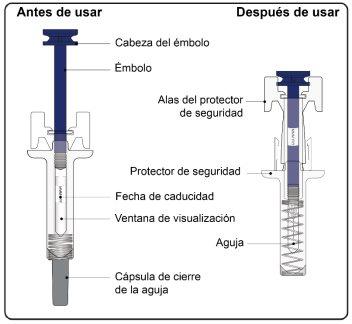
Important Information You Need to Know Before Injecting Jubbonti
| |
Storage of Jubbonti | |
| |
Preparing to Inject Jubbonti | |
Step 1. Allow to Reach Room Temperature Remove the packaging containing the prefilled syringe from the refrigerator and leave it closed for 15 to 30 minutes to allow it to reach room temperature. |
|
Step 2. Gather Materials Make sure you have the following (not included in the packaging):
|
|
Step 3. Unpack Open the plastic container by removing the cover. Remove the prefilled syringe by holding it in the middle as shown. Do notremove the needle closure cap until you are ready for injection. |
|
Step 4. Perform Safety Checks Look through the viewing window of the prefilled syringe. The liquid it contains should be a clear to slightly opalescent solution, colorless to slightly yellowish or slightly brownish. You may see air bubbles in the liquid; this is normal. Do notattempt to remove the air.
In any of these cases, contact your doctor, nurse, or pharmacist. |
|
Step 5. Choose the Injection Site You should inject into the front of the thighs or the lower abdomen, exceptin an area of 5 cm around the navel. Do not injectinto areas where the skin is sensitive, bruised, red, scaly, or thickened, or into areas with scars or stretch marks. If your caregiver, doctor, or nurse administers the injection, they can also inject into the upper arm. |
|
Injecting with Jubbonti | |
Step 6. Clean the Injection Site Wash your hands with soap and water. Clean the chosen injection site with an alcohol swab. Let it dry before injecting. Do nottouch or blow on the cleaned area before injecting. |
|
Step 7. Remove the Needle Closure Cap Pull firmly to remove the needle closure cap from the prefilled syringe. You may see a drop of liquid at the end of the needle; this is normal. Do notput the needle closure cap back on. Discard the needle closure cap. |
|
Step 8. Insert the Needle Gently pinch the injection site and hold the skin pinched when injecting. With the other hand, insert the needle into the skin at an angle of approximately 45 degrees as shown. Do notpress the plunger when inserting the needle. |
|
Step 9. Start the Injection Continue to pinch the skin. Slowly press the plunger all the way. This will ensure that the full dose is injected. |
|
Step 10. Complete the Injection Confirm that the plunger head is between the safety protector wings as shown. This will ensure that the safety protector has been activated and will cover the needle once the injection is complete. |
|
Step 11. Release the Plunger While keeping the prefilled syringe in the injection site, slowly release the plunger until the safety protector covers the needle. Remove the prefilled syringe from the injection site and stop pinching. You may see a small amount of blood at the injection site. You can press the injection site with a cotton ball or swab until the bleeding stops. Do notrub the injection site. If necessary, apply an adhesive bandage. |
|
After the Injection | |
Step 12. Dispose of the Prefilled Syringe Place the prefilled syringe in a sharps disposal container immediately after use. Do notthrow the prefilled syringe in the trash. Ask your doctor or pharmacist about the proper disposal of the sharps disposal container. It should be disposed of according to local regulations. |
|
- Country of registration
- Active substance
- Prescription requiredYes
- Manufacturer
- CompositionSORBITOL (47 mg mg), POLISORBATO 20 (0,10 mg mg), HIDROXIDO DE SODIO (E 524) (c.s.p. 60 mg mg)
- This information is for reference only and does not constitute medical advice. Always consult a licensed doctor before taking any medication. Oladoctor is not responsible for medical decisions based on this content.
- Alternatives to JUBBONTI 60 mg INJECTABLE SOLUTION IN PRE-FILLED SYRINGEDosage form: INJECTABLE, 120 mgActive substance: denosumabManufacturer: Fresenius Kabi Deutschland GmbhPrescription requiredDosage form: INJECTABLE, 120 mgActive substance: denosumabManufacturer: Fresenius Kabi Deutschland GmbhPrescription requiredDosage form: INJECTABLE, 60 mgActive substance: denosumabManufacturer: Fresenius Kabi Deutschland GmbhPrescription required


